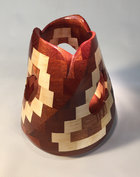- Joined
- Feb 28, 2021
- Messages
- 1,777
- Likes
- 1,589
- Location
- Roulette, PA
- Website
- www.reallyruralwoodworks.com
For usable bowls - that is, for a bowl that is meant to be actually used (kitchen or whatever) - anyone care to offer up guidelines? I ask because I recently happened to run into someone that does bowl turning (definitely not an AAW member, though) and , I hesitate to criticize someone, but I know of him from LONG ago, and even back then, he had, let's say, a certain reputation, among certain circles that I was in... Anyhow, he took it upon himself to try to tell me that my bowls were Too THIN! (an 8 inch salad bowl in ash that is a bit over 1/4 inch wall thickness - maybe closer to 5/16 inch) and claimed that they "couldn't hold the weight" (whatever that was supposed to mean) I quite literally had to bite my tongue to try and remain polite (there were others around as well, none were turners.. but they'd known the guy much longer than they'd known me - I was the new kid on the block... so to speak)
Well , I got home, decided to test out what *I* think (thinking that my wall thickness was perfectly fine - HIS bowls were quite thick - most appeared to be over a half inch thick walls, even for a 7 or 8 inch bowl , though many that I saw were rather straight-sided.) I took my bowl and turned it upside down on the floor and actually just stood on it (as in like a step stool) and figured, if a bowl can hold 180 lbs of human being, it's probably plenty strong enough to hold as many apples or potatoes as could be fit into it...
So, my question is -- How thin is too thin? are there any sort of real guidelines (wall thickness to diameter ratios? particular use cases? ) Not looking for any validation (I am satisfied with my bowl results so far, for the use I intended them for when I turned them - I'm not letting some guy that may or may not really have a clue tell me what is right or wrong... since, really, there ISN'T really right or wrong when it comes to designs turned on the lathe..., right?) But, I'd definitely like to get some ideas from the REAL turners on this forum and the AAW as to what actually might be a little too thin or too thick, when a bowl is turned for a particular use or purpose..
Well , I got home, decided to test out what *I* think (thinking that my wall thickness was perfectly fine - HIS bowls were quite thick - most appeared to be over a half inch thick walls, even for a 7 or 8 inch bowl , though many that I saw were rather straight-sided.) I took my bowl and turned it upside down on the floor and actually just stood on it (as in like a step stool) and figured, if a bowl can hold 180 lbs of human being, it's probably plenty strong enough to hold as many apples or potatoes as could be fit into it...
So, my question is -- How thin is too thin? are there any sort of real guidelines (wall thickness to diameter ratios? particular use cases? ) Not looking for any validation (I am satisfied with my bowl results so far, for the use I intended them for when I turned them - I'm not letting some guy that may or may not really have a clue tell me what is right or wrong... since, really, there ISN'T really right or wrong when it comes to designs turned on the lathe..., right?) But, I'd definitely like to get some ideas from the REAL turners on this forum and the AAW as to what actually might be a little too thin or too thick, when a bowl is turned for a particular use or purpose..

